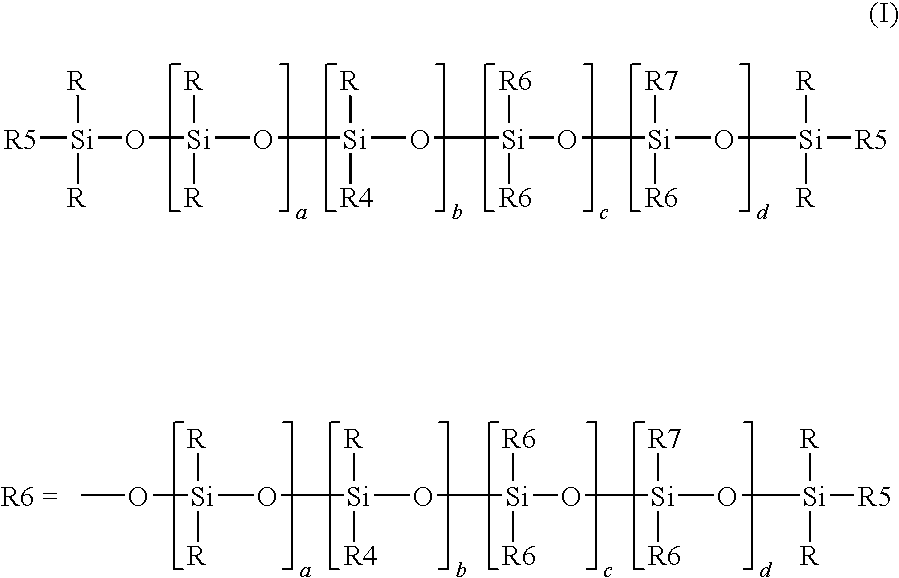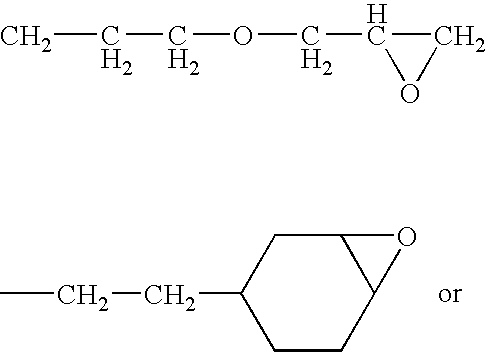Compositions containing polyether-polysiloxane copolymers
a polyether and polysiloxane technology, applied in the field of polyether-polysiloxane copolymers, can solve the problems of restricting storage stability, and achieve the effects of high quality, good stability and low cos
- Summary
- Abstract
- Description
- Claims
- Application Information
AI Technical Summary
Benefits of technology
Problems solved by technology
Method used
Image
Examples
examples
[0118]The proportion of alkoxy radicals —OR8 is defined according to formula (I) as the proportion of —OR8 in the sum of the radicals R4, R5 and R7. The molar fraction of alkoxy radicals —OR8 was determined by calculating the ratio of the respective area integrals in a 29Si-NMR spectrums. It is possible to employ either the spectrum of the end product (formula (I)) or of the hydrogensiloxane serving as precursor (formula (II)), since the alkoxyl radicals are largely retained during the hydrosilylation. The 29Si-NMR measurement, with which a person skilled in the art will be familiar, is of greater accuracy at the stage of the hydrogensiloxane because of the lower dilution of the silicone part. The structures disclosed here were determined by measurement of the hydrogensiloxane and calculating the ratio of the appropriate integrals.
examples 1 to 7
Preparation of Compositions of the Invention
[0119]The hydrogensiloxanes were prepared by means of the process described in the present text and the process described in the as yet unpublished patent applications DE 102008041601 and DE 102007055485.2. The amounts of siloxane and silane starting materials used were calculated according to the proportions of monomeric siloxy units required in the respective illustrative formulation. The preparation was carried out by a method analogous to Example 1 of DE 102008041601. The amount of water was calculated so that the reaction did not proceed to 100%. Instead of one equivalent of water per silane-bonded alkoxy equivalent, a maximum of 0.5 equivalent of water per silane-bonded alkoxy equivalent was used in each case. In the introduction of very small amounts via a dropping funnel, retention of substance on the wetted glass wall or the greased glass stopcock cannot be avoided without the undesirable use of additional solvent and the actual a...
example 8
Application Area of Rigid Foam Panel and Insulation Board
[0127]Two different formulations which were matched to these fields of use and whose composition is indicated in Table 4 were used.
[0128]
TABLE 4Formulations for rigid foam panel / insulation board, in parts by massFormulationA: PUR panelB: PIR insulation boardPolyolPolyether polyol blendStepanpol PS 2352* 70 parts100 partsTris(1-chloro-2-propyl) phosphate 30 parts 15 partsN,N,N′,N″,N″- 0.2 part 0.2 partPentamethyldiethylenetriamineN,N-Dimethylcyclohexylamine 2.0 parts—Potassium octoate (75% by weight in— 4.0 partsdiethylene glycol)Water 1.0 part 0.4 partn-Pentane 6.0 parts 20 partsStabilizer 2.0 parts 2.0 partsDesmodur 44V20L**140 parts200 parts*Polyester polyol from Stepan**Polymeric MDI from Bayer, 200 mPa * s, 31.5% of NCO, functionality: 2.7
[0129]A masterbatch of each of the two systems was firstly made up from polyol, flame retardant, catalysts and water and in each case divided into 6 equal parts. Two of each were admixed ...
PUM
| Property | Measurement | Unit |
|---|---|---|
| mol % | aaaaa | aaaaa |
| pressure | aaaaa | aaaaa |
| temperature | aaaaa | aaaaa |
Abstract
Description
Claims
Application Information
 Login to View More
Login to View More - R&D
- Intellectual Property
- Life Sciences
- Materials
- Tech Scout
- Unparalleled Data Quality
- Higher Quality Content
- 60% Fewer Hallucinations
Browse by: Latest US Patents, China's latest patents, Technical Efficacy Thesaurus, Application Domain, Technology Topic, Popular Technical Reports.
© 2025 PatSnap. All rights reserved.Legal|Privacy policy|Modern Slavery Act Transparency Statement|Sitemap|About US| Contact US: help@patsnap.com



